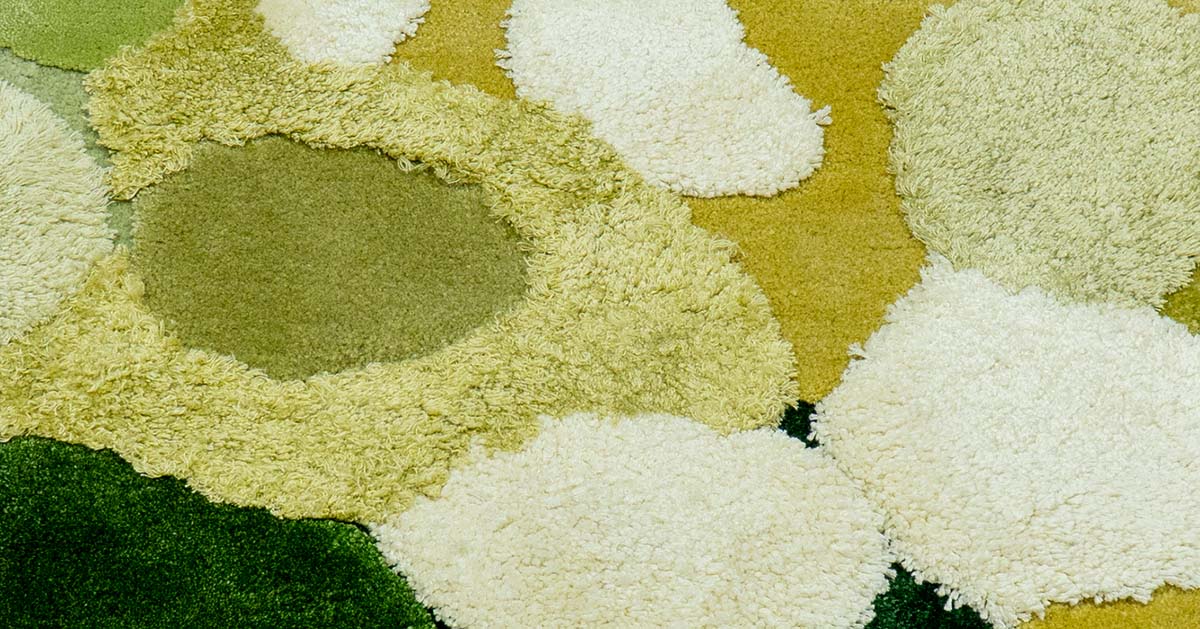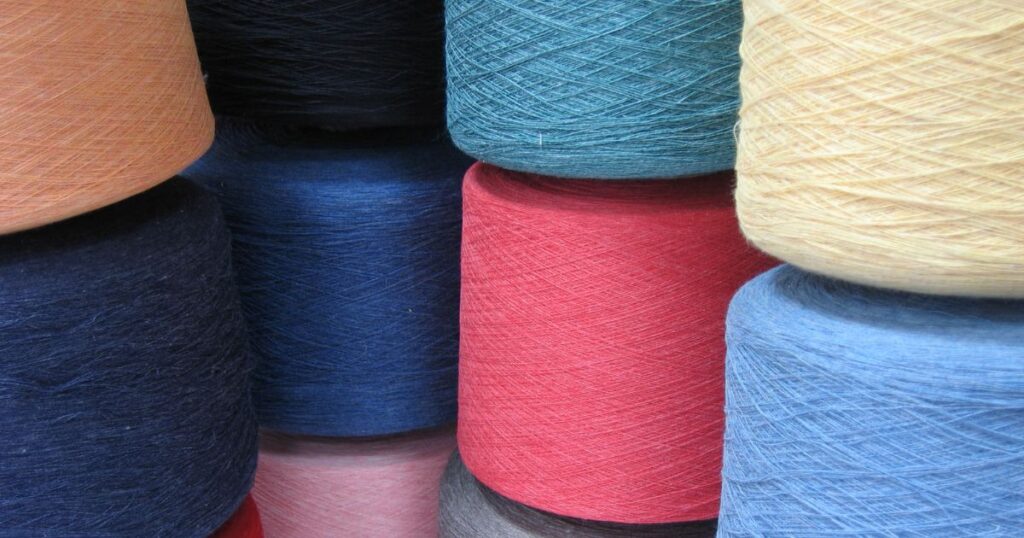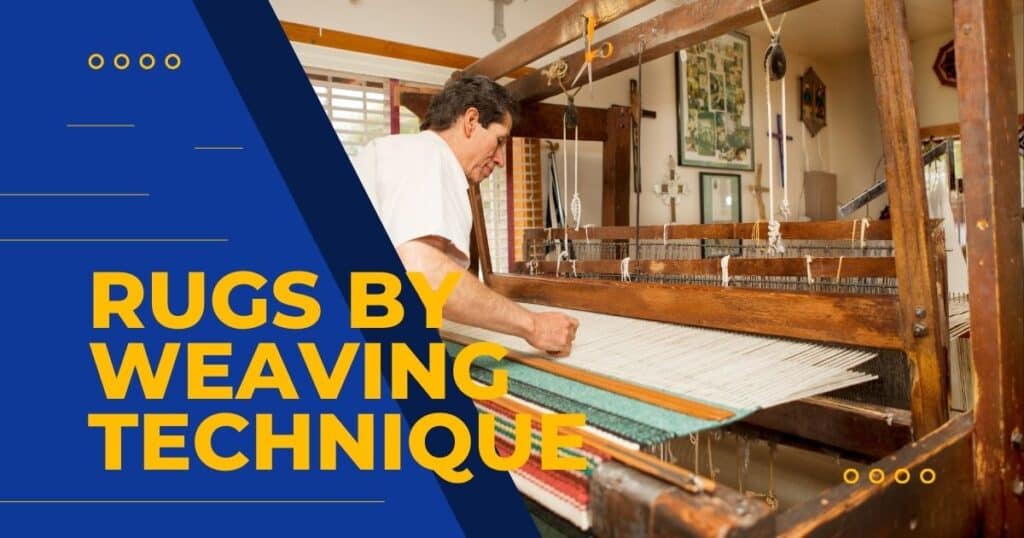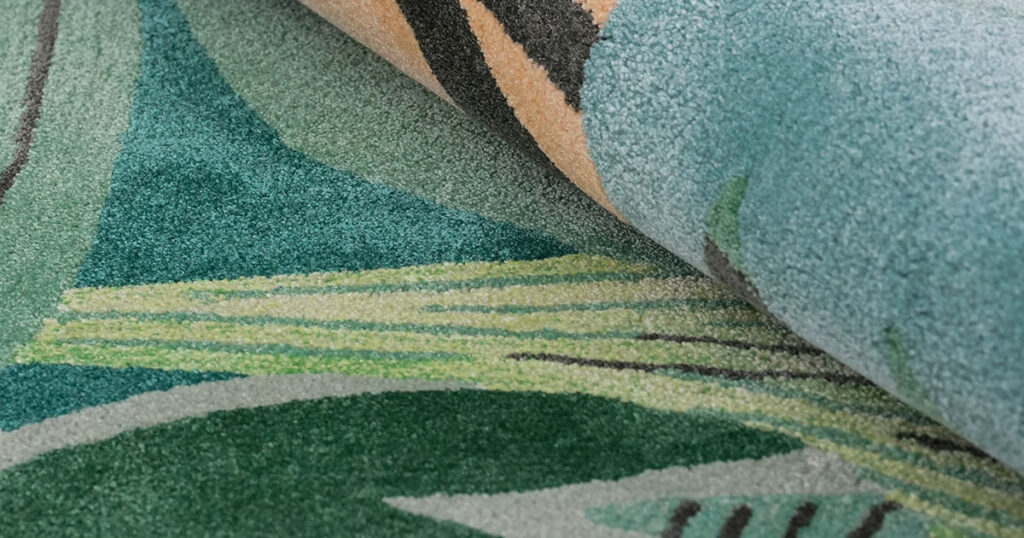When you’re in the market for a new tufted rug, the yarn type is one of the most crucial factors that determines not just how the rug looks, but how it performs over time.
Each fiber brings its own unique properties to your floors.
Let’s explore these fibers and uncover what makes each one unique.
And help you make an informed choice for your home.
New Zealand Wool: The Gold Standard
New Zealand wool stands as the premium choice in the world of tufted rugs, and for good reason.
Harvested from sheep raised in New Zealand’s pristine environments, this wool is exceptionally clean and white, allowing it to accept vivid dyes while maintaining its natural beauty.
Superior Durability and Resilience
What makes New Zealand wool truly special is its inherent resilience.
- The fibers have a natural crimp or waviness that acts like tiny coiled springs.
- This feature helps the tufted wool rug bounce back after being compressed by furniture or foot traffic.
This natural elasticity means a wool rug can maintain its appearance for decades when properly cared for. The tensile strength of wool fibers also contributes to their impressive durability, allowing them to withstand years of abrasion without breaking down.
Natural Stain and Soil Resistance
Wool offers remarkable stain resistance thanks to its natural lanolin coating. This waxy substance creates a protective barrier that gives you precious time to blot spills before they penetrate the fiber. The microscopic scales on wool fibers also help repel liquids and dirt. Wool naturally doesn’t build up static electricity, so it doesn’t attract dust as synthetics can, keeping it cleaner longer. Even when soiled, wool has a unique ability to hide dirt until it’s vacuumed out.
Environmental and Health Benefits
For those concerned about indoor air quality, wool rugs can actually improve your home’s environment. The fiber naturally regulates humidity, resists mold and mildew, and can even trap airborne pollutants until they’re removed during vacuuming. As a renewable resource, wool is biodegradable and sustainable – sheep grow new fleece annually, and at the end of a wool rug’s long life, it will eventually break down rather than persisting in landfills for centuries.
Acrylic: Wool’s Synthetic Cousin
Often marketed as “art wool,” acrylic was specifically developed to mimic wool’s appearance and feel at a more accessible price point. This synthetic fiber offers a remarkable similarity to wool’s matte appearance and soft touch, making it difficult to distinguish from the real thing from a distance.
Wool-Like Aesthetics at Budget Prices
Acrylic feels pleasantly soft underfoot and can be made springy and plush, providing good comfort in bedrooms or sitting areas. The fiber takes dyes exceptionally well, resulting in bright, clear colors that resist fading. From a distance, a well-made acrylic rug can be mistaken for wool, yet it typically costs significantly less – making it an attractive option for those who love wool’s appearance but face budget constraints.
Practical Resistance Properties
Because it’s synthetic, acrylic won’t be damaged by moths or beetles, and it resists mildew better than natural fibers—a plus in slightly humid environments. Acrylic generates very little static electricity, meaning it doesn’t attract as much dust or lint as some other synthetics. It’s also typically easy to clean, handling normal carpet shampoos or mild detergents without damage.
Performance Limitations
Where acrylic falls short is in resilience and durability. The fibers don’t have wool’s natural spring, meaning an acrylic rug will begin to show flattening in high-traffic areas relatively quickly. The fiber can also pill and fuzz with abrasion, similar to an acrylic sweater. Another weakness is its attraction to oily substances—cooking oil, skin oils, or even greasy residue from shoes can bind to acrylic fibers and be difficult to remove completely. Heat sensitivity is also a concern; acrylic has a relatively low melting point compared to other fibers.
Rayon (Viscose): Silk’s Affordable Alternative
Walk into a high-end showroom and you’ll likely be drawn to rugs with an entrancing sheen—many of these are made with viscose rayon, often called “art silk.” Unlike purely synthetic fibers, viscose is made by chemically processing natural cellulose (usually from wood pulp) to create fibers that remarkably mimic silk’s lustrous appearance.
Luxurious Appearance and Feel
The appeal of viscose is immediately obvious: it has a beautiful silky sheen that catches light dramatically, creating a play of highlights and lowlights across a rug’s surface. The texture is exceptionally smooth—almost buttery to the touch—providing a luxurious feel underfoot. Viscose also accepts dyes beautifully, resulting in rich, saturated colors with impressive depth that seem to change depending on viewing angle, much like genuine silk.
Extreme Moisture Sensitivity
Viscose’s most critical weakness is its reaction to moisture. When wet, viscose can lose up to 50% of its strength, and fibers can actually kink or harden permanently. Even a small water spill can cause lasting damage, often leaving watermarks, yellowing, or stiff areas after drying. This extreme sensitivity means viscose rugs should never be placed in bathrooms, kitchens, entry areas, or spaces where spills are likely.
Challenging Maintenance Requirements
Because of its fragility, viscose demands meticulous care. Professional cleaners often dread viscose rugs – they require specialized cleaning methods as standard wet cleaning can cause irreversible fiber distortion. At home, viscose rugs should be vacuumed with suction only (no beater bar), and any spills require immediate, gentle blotting without rubbing. The fiber also lacks resilience, meaning it crushes easily under furniture or regular foot traffic and doesn’t recover. Areas that see even moderate use will develop a visibly matted appearance that can’t be restored.
Bamboo Silk: Eco-Glamour with Limitations
Bamboo silk represents a marketing evolution in the world of rayon fibers. Essentially a type of viscose derived from bamboo cellulose instead of wood pulp, it offers the same silky appearance while capitalizing on bamboo’s reputation as a sustainable resource.
Sustainable Source Material
The appeal of bamboo silk begins with its raw material. Bamboo is one of the fastest-growing plants on Earth (some species grow up to a meter per day), requires minimal water, and doesn’t need replanting after harvesting since it regrows from its root system. This renewable resource requires no pesticides and helps prevent soil erosion, giving bamboo silk an eco-friendly origin story that appeals to environmentally conscious consumers.
Silky Aesthetics with Slight Improvements
Like standard viscose, bamboo silk provides that coveted luxurious sheen and exceptionally soft feel. Some manufacturers claim their bamboo silk has slightly improved durability and cleanability compared to traditional viscose. Anecdotally, many users report that bamboo silk rugs shed a bit less and feel somewhat stronger when tugged compared to standard viscose. The fiber is remarkably cool to the touch, which can be particularly pleasant in warm climates.
Processing Reality Check
While bamboo as a plant is sustainable, the standard process for turning it into bamboo viscose involves chemical-intensive methods similar to traditional viscose production. Unless specifically labeled as lyocell or made via a closed-loop process, bamboo silk’s environmental manufacturing impact can be similar to standard viscose’s. This creates a disconnect between the eco-friendly raw material and the less environmentally friendly processing—an important consideration for truly eco-conscious consumers.
Tencel (Lyocell): The Sustainable Silk Alternative
Tencel represents a significant advancement in rayon technology, offering silk-like beauty with improved performance and genuine environmental benefits. A branded lyocell fiber produced by Lenzing AG, Tencel is made from sustainably harvested wood pulp (often eucalyptus) using a closed-loop production process that recovers and reuses 99% of the solvents.
Enhanced Durability and Maintenance
What sets Tencel apart from standard viscose is its improved strength and resilience. The fibers have what’s called a “high tenacity profile,” meaning they’re more resistant to breaking even when wet. This translates to better durability, less shedding, and improved cleanability in rug applications. While still not as tough as wool or nylon, Tencel will outlast viscose in similar use conditions. It also handles maintenance better – it can typically withstand careful professional cleaning and is less likely to develop permanent water stains if spills are promptly addressed.
Superior Moisture Management
Tencel offers much better moisture handling than viscose. It can absorb and release moisture efficiently without the dramatic weakening that afflicts viscose when wet. This moisture management also makes Tencel naturally resistant to bacterial growth and dust mites, contributing to better indoor air quality. Colors appear vibrant and long-lasting on Tencel due to its excellent dye uptake and color retention properties.
True Environmental Credentials
From an environmental perspective, Tencel truly shines. The closed-loop manufacturing process dramatically reduces chemical waste compared to traditional viscose production. It uses less energy and water than cotton cultivation, and the wood source is typically certified sustainable plantations. The fiber is fully biodegradable, avoiding the microplastic pollution concerns associated with synthetic alternatives. For consumers seeking luxury appearance with genuine eco-benefits, Tencel offers the most credible combination.
Cotton: Casual Comfort with Trade-offs
Cotton brings a relaxed, natural vibe to the world of tufted rugs. This plant fiber has been used in textiles for thousands of years and offers a comfortable, unpretentious quality that works beautifully in casual spaces.
Practical Washability
The standout practical advantage of cotton rugs is that many smaller versions are machine-washable. This makes cotton the go-to fiber for bath mats, kitchen rugs, and children’s room rugs where frequent cleaning is necessary. Being able to simply toss a soiled rug into the washing machine offers convenience that most other rug fibers can’t match. Cotton also cleans relatively well, with most stains coming out in standard laundering.
Natural Comfort and Breathability
Cotton rugs feel naturally soft against bare feet without any synthetic slickness. The fiber breathes well and doesn’t trap heat, creating a cool, comfortable surface in warmer climates. Cotton doesn’t generate static electricity and doesn’t off-gas volatile compounds, making it a good choice for those with chemical sensitivities. Its natural, matte appearance suits casual, relaxed décor styles from farmhouse to bohemian.
Limited Durability and Resilience
Cotton’s primary drawback is its poor resilience – once compressed by furniture or foot traffic, it stays flat. It simply lacks the spring-back quality of wool or nylon, meaning cotton rugs in traffic areas quickly develop matted paths that can’t be restored. The fiber is also highly absorbent, making it vulnerable to staining from colored liquids and prone to mildew if left damp. These characteristics severely limit cotton’s practicality for large area rugs in high-use spaces, relegating it primarily to smaller, washable formats or very casual, frequent-replacement rugs.
Nylon: The Durability Champion
When it comes to withstanding the rigors of daily life, nylon stands as the undisputed champion among synthetic rug fibers. Developed in the 1930s, this polyamide fiber revolutionized the carpet industry with its remarkable combination of strength, resilience, and reasonable softness.
Unmatched Resilience and Longevity
Nylon’s most impressive quality is its elastic recovery—the ability to stretch up to 30% and spring back to its original shape. This property allows nylon rugs to withstand compression from furniture and foot traffic without permanently flattening. In practical terms, a nylon rug in a busy hallway will maintain its appearance far longer than other synthetics. The fiber’s exceptional tensile strength also means it resists breaking and abrasion, even after years of vacuuming and cleaning. It’s not uncommon for quality nylon rugs to last 10-15 years in residential settings while maintaining good appearance.
Stain Resistance and Cleanability
Early nylon’s primary weakness was its potential to stain, as the fiber is naturally absorbent. However, modern nylon rugs almost always feature sophisticated stain-resistant treatments or solution-dyeing (where color is added to the molten polymer), making them remarkably stain-resistant. The fiber can be cleaned vigorously without damage – nylon can withstand hot water extraction cleaning and strong cleaning agents better than most fibers. Many solution-dyed nylons can even handle diluted bleach solutions for stubborn stains without color loss.
Versatility in Design and Application
Nylon can be engineered in various textures, from dense, low-loop piles for commercial use to thick, velvety saxony cut piles in residential applications. It accepts dyes readily, allowing for vibrant colors and intricate patterns. Modern nylon also comes in different grades of softness – some residential nylon carpets feel surprisingly plush and comfortable underfoot. This versatility makes nylon appropriate for virtually any setting, from corporate offices to family rooms, with styles ranging from formal to casual.
Polypropylene (Olefin): Budget-Friendly and Weather-Resistant
Polypropylene (often called olefin) has carved out a specific niche in the rug market as the go-to fiber for budget-conscious consumers and outdoor applications. This synthetic polymer is remarkably inexpensive to produce, making it possible to create large area rugs at very accessible price points.
Exceptional Water and Stain Resistance
The most distinctive property of polypropylene is its complete imperviousness to water. The fiber is hydrophobic—it simply does not absorb moisture. This makes polypropylene rugs extraordinarily resistant to water-based stains; spills tend to bead up on the surface rather than penetrating, giving you ample time to blot them away. This same quality makes polypropylene naturally resistant to mold and mildew, as the fiber doesn’t retain the moisture necessary for these organisms to grow. Many polypropylene rugs can literally be hosed off outdoors to clean them.
Superior Colorfastness and UV Resistance
Another significant advantage is polypropylene’s excellent colorfastness. Most polypropylene rugs are solution-dyed, meaning the color is incorporated into the molten polymer before fiber extrusion. This makes the color inherent to the fiber rather than just a surface treatment, resulting in remarkable resistance to fading from sunlight or cleaning chemicals. Even prolonged exposure to intense sunlight won’t significantly fade a good-quality polypropylene rug, making it perfect for sunrooms, patios, or poolside use. Many polypropylene rugs can even be cleaned with diluted bleach without affecting their color.
Significant Performance Limitations
The trade-off comes in durability and resilience. Polypropylene has the lowest resilience of common rug fibers—it crushes easily under furniture or foot traffic and generally doesn’t recover. Over time, high-traffic areas will develop visibly flattened paths that can’t be restored. The fiber also has a low melting point (around 160°C/320°F) and can be damaged by friction heat from dragging heavy furniture. Perhaps most problematically, while polypropylene repels water beautifully, it has a strong affinity for oils. Oily substances from cooking residue to body oils can bind with the fiber and attract dirt, leading to dingy areas that remain even after cleaning.
Polyester: Softness and Color at Moderate Prices
Polyester has gained significant market share in the residential rug sector, particularly as advances in manufacturing have improved its softness and appearance. Made from the same PET plastic as water bottles (and indeed, often incorporating recycled content), polyester offers a practical middle ground between price and performance.
Exceptional Softness and Comfort
The first thing you’ll notice about modern polyester rugs is their remarkable softness. Technological advances have allowed manufacturers to create extremely fine polyester filaments, resulting in rugs with a plush, velvety feel that rivals much more expensive materials. This softness makes polyester particularly popular for bedroom rugs, nurseries, or any space where comfort underfoot is a priority. Unlike some other synthetic fibers that can feel slick or plastic-like, quality polyester can have a truly luxurious hand feel.
Vibrant Color and Stain Resistance
Polyester excels in color clarity and vibrancy. The fiber accepts dyes readily and holds them well, allowing for deep, saturated colors that resist fading. This makes polyester a go-to choice for rugs with bold patterns or vibrant hues that need to maintain their visual impact over time. Like polypropylene, polyester is inherently stain-resistant to water-based spills due to its hydrophobic nature. A spilled glass of juice or wine will typically bead up rather than immediately penetrating, giving you time to blot it away before staining occurs.
Sustainability and Performance Considerations
An exciting aspect of modern polyester rugs is that many are made from recycled PET bottles. These “green” polyester rugs help divert plastic from landfills while creating a functional product. However, polyester does have performance limitations. It lacks the strong elastic recovery of nylon or wool, meaning it tends to crush under furniture or in heavy traffic areas. Over time, these compressed areas develop a noticeably different texture than unworn portions of the rug. Additionally, like most synthetics, polyester has an affinity for oils, which can lead to permanent staining from things like salad dressing spills or body oils from bare feet.
Blended Yarns: The Best of Both Worlds
Sometimes one fiber alone can’t provide everything you need in a rug, which is why manufacturers often blend different materials to combine their strengths. These blended yarns allow for interesting performance combinations that might not be possible with a single fiber type.
Wool-Nylon: The Performance Blend
Perhaps the most successful blend in the rug world is the 80/20 wool-nylon combination common in high-end commercial carpeting. This ratio maintains wool’s luxurious feel and appearance while the nylon content adds extra abrasion resistance and strength—essentially creating a wool rug with enhanced durability. The 80/20 ratio is carefully chosen to ensure the wool characteristics remain dominant while gaining just enough synthetic reinforcement to improve long-term wear. This blend performs exceptionally well in high-traffic areas like hotel lobbies and busy family rooms, where the natural qualities of wool are desired but with added resilience.
Wool-Viscose: The Decorative Blend
For decorative purposes, wool-viscose blends have become extremely popular. Typically featuring wool as the primary component with viscose highlights, these rugs offer wool’s durability for the main surface while using viscose’s sheen to accentuate pattern elements or create textural contrast. The result is a rug with visual depth and dimension that would be difficult to achieve with a single fiber. In these rugs, viscose is strategically placed in areas less likely to see heavy traffic, while the wool provides the structural integrity. These blends work best in moderate-traffic living areas where some visual drama is desired.
Synthetic Blends and Multi-Fiber Combinations
Beyond the common wool combinations, manufacturers create various synthetic blends to achieve specific performance or price targets. Nylon-polypropylene blends, for example, aim to combine nylon’s durability with polypropylene’s stain and moisture resistance. Polyester-nylon blends might incorporate a small percentage of nylon to boost the resilience of a primarily polyester rug. Some value-oriented rugs blend wool with acrylic or polyester to lower costs while maintaining some wool characteristics, though these typically sacrifice significant performance compared to pure wool. When evaluating these blends, remember that a rug generally behaves in proportion to its components—an 80/20 blend will perform roughly 80% like the dominant fiber and 20% like the secondary one.
Choosing the Right Yarn for Your Rug
After exploring all these fiber options, how do you decide which is right for your specific situation? The key is to match the material’s strengths to your priorities, considering factors like location, traffic patterns, likelihood of spills, maintenance willingness, aesthetic goals, and budget.
Traffic Patterns and Durability
For high-traffic areas like entryways, hallways, or busy family rooms, durability should top your priority list. Here, wool or nylon reigns supreme. New Zealand wool offers natural resilience and dirt resistance that will serve you well for decades, while nylon provides synthetic toughness that won’t flatten under constant foot traffic. A wool-nylon blend (like an 80/20 mix) offers an excellent compromise, combining wool’s natural benefits with nylon’s added abrasion resistance. For stairs, which take particularly focused wear, nylon is often the most practical choice due to its superior tensile strength.
Spill Risk and Cleaning Requirements
In spaces where moisture or spills are common concerns—dining rooms, kitchens, or children’s play areas—consider stain resistance carefully. Solution-dyed nylon offers an excellent balance of durability and stain protection, while polyester naturally repels water-based spills. For outdoor spaces or areas prone to dampness, polypropylene’s complete moisture resistance makes it the logical choice despite its limited durability. Areas prone to oily spills (like near a kitchen) might be better served by wool, which handles oils better than most synthetics. Also consider your cleaning preferences—if you want the option to machine-wash, smaller cotton rugs are your best bet.
Aesthetic Goals and Room Usage
Different rooms call for different rug priorities. Bedrooms and formal living rooms that see light use allow you to prioritize look and feel over extreme durability. This is where wool-viscose blends, Tencel, or even pure viscose can shine, offering luxurious texture and appearance. Children’s rooms might benefit from bright, washable polyester rugs that can handle play and periodic cleaning. For a luxurious master bedroom, consider a plush wool rug for its combination of softness and longevity, or a polyester shag for budget-conscious comfort. Remember that a rug is both a functional item and a design element—the fiber choice should support the overall aesthetic you’re trying to achieve in each space.
By thoughtfully matching fiber characteristics to your specific needs, you’ll find the perfect balance of beauty, performance, and value for each area of your home. The perfect rug isn’t just about appearance—it’s about finding the material that will maintain that appearance throughout its life in your unique environment.




